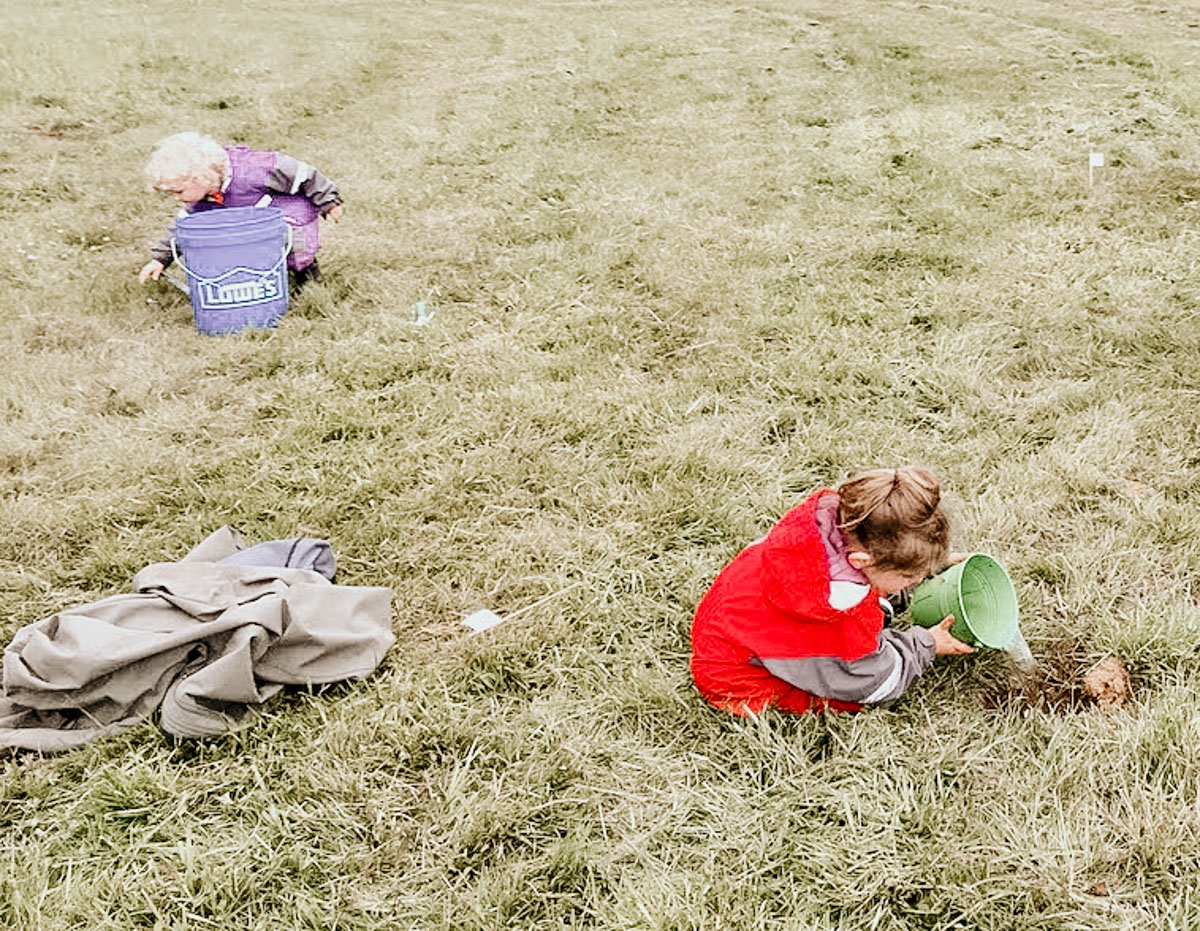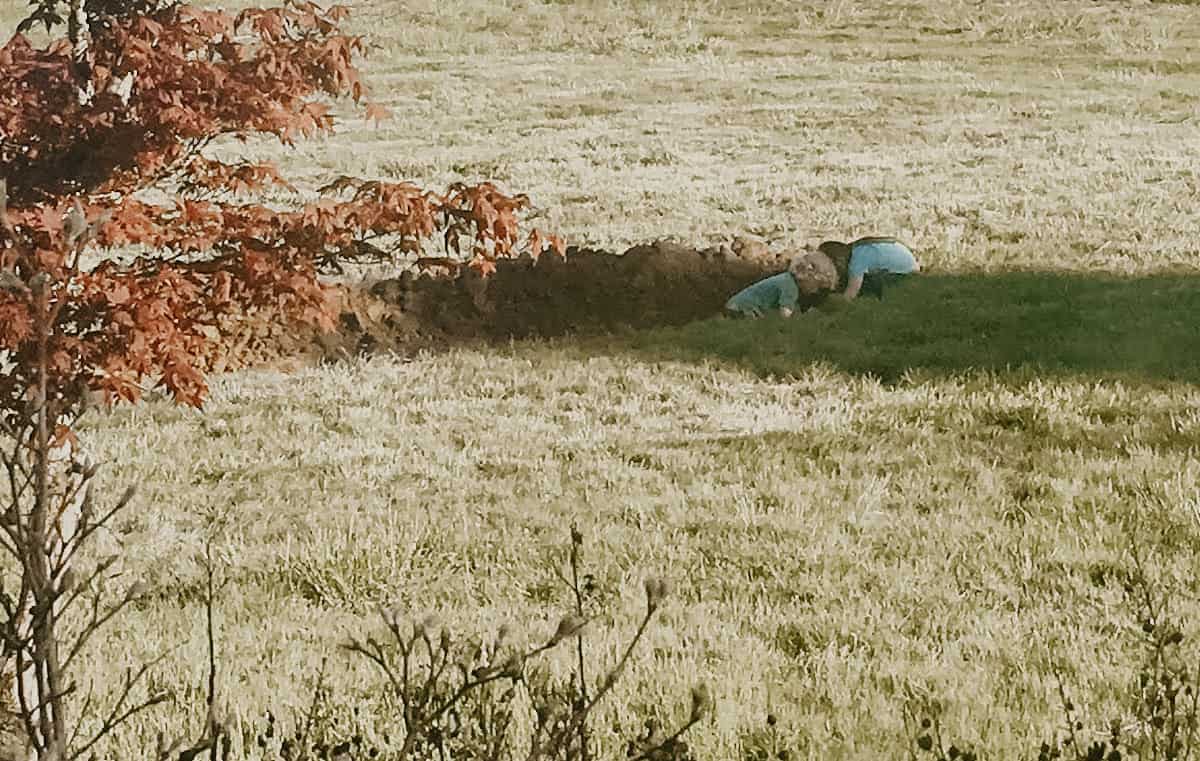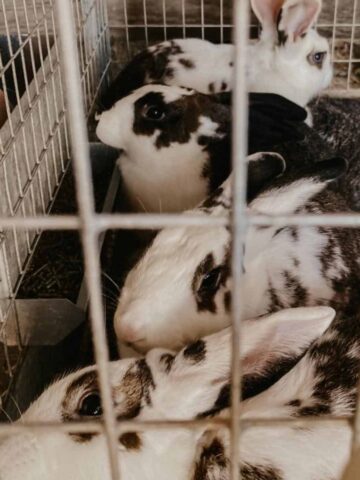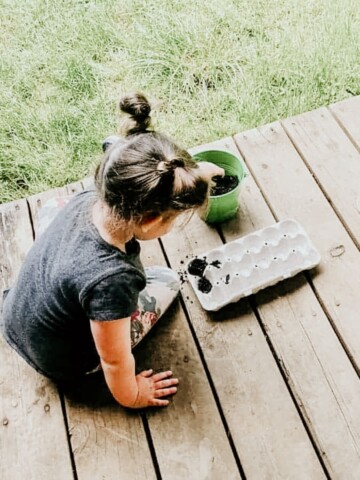
“Nature is painting for us, day after day, pictures of infinite beauty.”
– John Ruskin
Welcome! We’re continuing to share the progress on starting a PNW vegetable garden and today we're talking about establishing in-ground garden beds as well as composting for kids.
Disclosure of Material Connection: Some of the links in the post are “affiliate links.” This means if you click on the link and purchase the item, I will receive an affiliate commission. Amazon links are not affiliate links. You can read my full affiliate disclosure.
In-Ground Garden Beds
I assisted Kaia and Noah with their rain gear. Next, I put on my fanciest boots and my baby, before heading outside to start working on the in-ground garden beds.

Tools
- Gloves
- Boots (optional)
- Rain Gear (as needed)
- Tape Measure
- Hoe
- Spade
- Rake
- Trowel
- Wheelbarrow
- Buckets (for fun)

Garden Design
Our garden is actually going to be comprised of two separate vegetable garden beds and a buffer enclosed in net wire fencing tall enough to protect it from our local wildlife and with some room between the beds for walking, sitting, journaling, etc.
We will have approx. 96 sq. ft of area to grow, which is a great size for our family’s starter garden. The kids are very much active participants in the vegetable gardening experience and this will yield enough to feed our family conservatively while at the same time allowing us to effectively observe and mentor as needed.
This garden was designed for future growth so we have taken that into account throughout the planning process. Now, on to the actual vegetable garden beds.
Something to note: the circular arrows should be pointing the opposite direction. The plan is correct but the person who drew the arrows was still sleepy.
This post has great visual aids on crop rotation and an explanation of the benefits.
Considering Roundup Grass and Weed Killer?
Does Roundup cause cancer? Learn more about Roundup and why you should just say no to Roundup's Glyphosate. Also included are helpful alternatives for weed control that don't cause short-term or long-term health effects.
Find out more about Roundup lawsuits and the latest Roundup lawsuit info.
What About Asbestos Materials?
Minimize your risk of exposure to asbestos-containing materials. Here's some background information and a list of products and materials containing asbestos.

Measuring the Garden Site
Kaia measured out the area and helped mark it with some flags. The next step is to remove the existing layer of turf and transfer it to the compost pile. Kaia intermittently checked in on everyone's progress armed with a tape measure and a smile.

Digging the In-Ground Garden Beds
Kaia and Noah spent much of their time collaborating on the design and creation of a couple mud holes, just large enough for their Antarctic animals to go swimming in. Older kids may want to participate more in digging the beds.
Depending on the quality and texture of your soil, you may want to double-dig your beds for optimal drainage and root growth.

Garden Beds and a Play Space
Long after the day's work was over, Kaia and Noah were still exploring the in-ground garden beds, having fun with all the earthworms, grubs, and millipedes they could find.
A garden bed holds so many opportunities for exploration. Being able to take your time with this process is advantageous for everyone.

Composting for Kids
As we continue to work on our in-ground garden beds and fortify them with some fencing, we are also working on some other projects. We just recently finished setting up the site for our basic backyard composting. We chose a nice location in a wooded area with partial sun, behind our garage and near the workshop. It’s not too far from our home or our garden so we can conveniently add to the pile as needed and then transfer it to the garden using a wheelbarrow.
We created a simple temporary 3-sided border to protect the adjacent cement and structure and to provide a visual separation since the kids will be helping to manage the compost pile. I’m sure we’ll need to build a more significant enclosure for our compost pile, given the amount of wildlife roaming the property (I’m not going to point any fingers),

but this is a good starting point for now. The kids had a lot of fun setting it up.
For more on composting, this is a good general resource.
Farm Anatomy is an awesome family-friendly resource that contains all sorts of neat illustrations and information about anything related to farming. We actually love all three books in this series by Julia Rothman.
If you’ve been with us awhile, you’ve seen them pop up over and over again in our posts. This collection is part of our must-have books for homeschooling.
More Outdoor Practical Life in the Garden
- Outdoor Practical Life: Soil Composition Test/Sediment Jars
- Outdoor Practical Life: PNW Vegetable Garden – Soil Temp & DIY Soil pH Testing
- Vegetable Garden: Sun, Soil, Air, & Water… & Deer
- Montessori Gardening: Empower Kids to Grow Their Own Food & Eat Healthy - Farm to Table
In-Ground Garden Beds & Composting for Kids

Interested in kids' gardening activities? See how we establish in-ground garden beds and composting for kids.
Materials
- Gardening Gloves
- Boots (optional)
- Rain Gear (optional)
- Tape Measure
- Hoe
- Spade
- Rake
- Trowel
- Wheelbarrow
- Buckets (for fun)
Tools
- See Materials List
Instructions
- Design a garden appropriate for your interests and needs. Around 100 square feet is a good size for a beginner but any size will work.
- Use the tape measure to measure the space for your garden and mark it for digging.
- Remove any turf as needed. This can be placed in your compost.
- Dig or double-dig your beds to your specifications using your gardening tools. Kids may participate or play alongside you while you work.
- Allow kids adequate time to explore the garden beds for bugs, worms, etc.
- Identify a location for your compost pile, preferably not too far from your garden and with at least partial shade. Consider whether you need an enclosure for your compost.
- Consult resources mentioned for more information about composting.
Notes
- Full lesson available at: https://happyhomeschooladventures.com/outdoor-practical-life-pnw-vegetable-garden-bed-establishment-diy-compost/





Leave a Reply